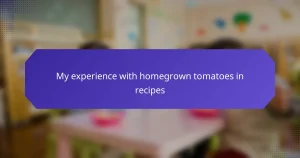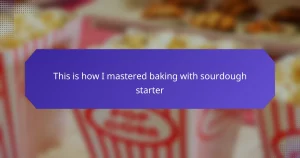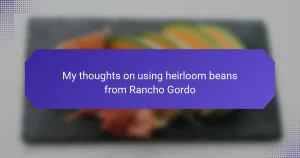Key takeaways
- Understanding different types of yeast, such as Active Dry, Instant, and Fresh, can enhance your bread-making experience.
- Using high-quality ingredients, including all-purpose flour, warm water, and Red Star yeast, is crucial for achieving delicious results.
- Following a step-by-step process, from combining ingredients to proper kneading and rising, allows for a successful bread outcome.
- Personal insights, such as checking yeast freshness and measuring accurately, can significantly improve your baking results.
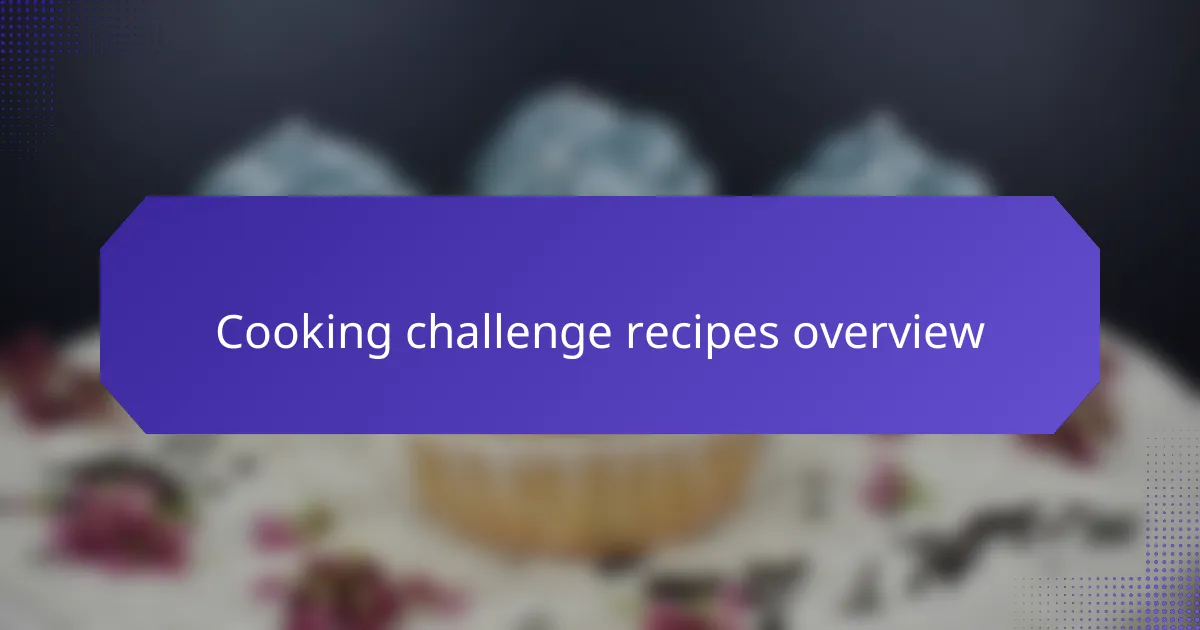
Cooking challenge recipes overview
When I embarked on my journey to bake bread with Red Star yeast, it quickly became more than just a recipe; it turned into a rewarding challenge. Baking with yeast can be intimidating at first, but the satisfaction of watching the dough rise is truly magical. It’s like a mini science experiment happening right in your kitchen!
Understanding the differences between various yeast options can elevate your baking experience significantly. While I have my personal favorite, there are several types available, each bringing a unique flavor and texture to your bread. Here’s a quick comparison of some common types of yeast to help you choose the best one for your own baking adventures.
| Type of Yeast | Characteristics |
|---|---|
| Active Dry Yeast | Needs to be dissolved in warm water before use; great for beginners. |
| Instant Yeast | No need for activation; it can be mixed directly into dry ingredients; more potent than active dry yeast. |
| Fresh Yeast | Perishable, provides a distinct flavor; requires careful handling and storage. |
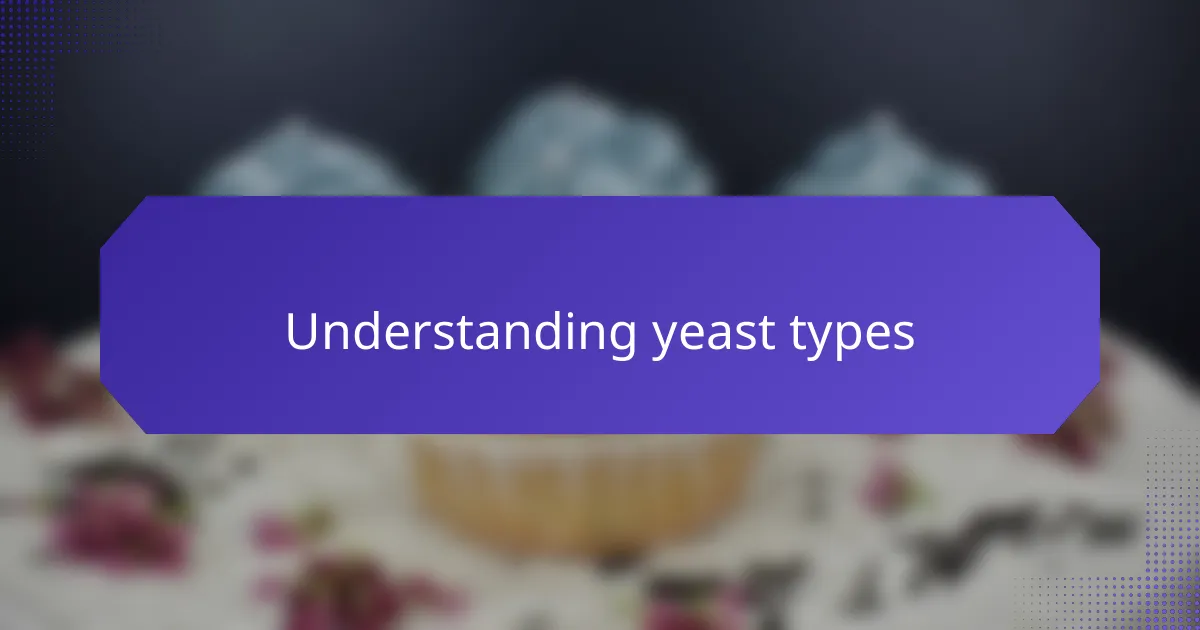
Understanding yeast types
When it comes to baking bread with yeast, understanding the different types of yeast is crucial. I’ve found that yeast can make or break your baking experience. For instance, during my first attempt with Red Star yeast, I learned that there are different varieties, such as active dry yeast and instant yeast, each with its unique characteristics and usage.
Active dry yeast requires proofing in warm water before use, which I discovered can be a little tricky if you’re not paying attention to the temperature. It’s fascinating how a little science can influence the fluffiness of your bread! Instant yeast, on the other hand, can be added directly to dry ingredients, which I appreciate for how straightforward and efficient it feels.
Here’s a quick breakdown of yeast types:
- Active Dry Yeast: Needs proofing before mixing; great for traditional recipes.
- Instant Yeast: Can be mixed directly; perfect for quick and easy baking.
- Fresh Yeast: Perishable and often used in commercial baking for its potency; requires refrigeration.
- Rapid-Rise Yeast: A type of instant yeast that works fast, reducing rising time, which is handy for those last-minute baking needs.
These little nuggets of knowledge make all the difference in the baking process, and I can’t stress enough how much joy and satisfaction comes from understanding your ingredients.
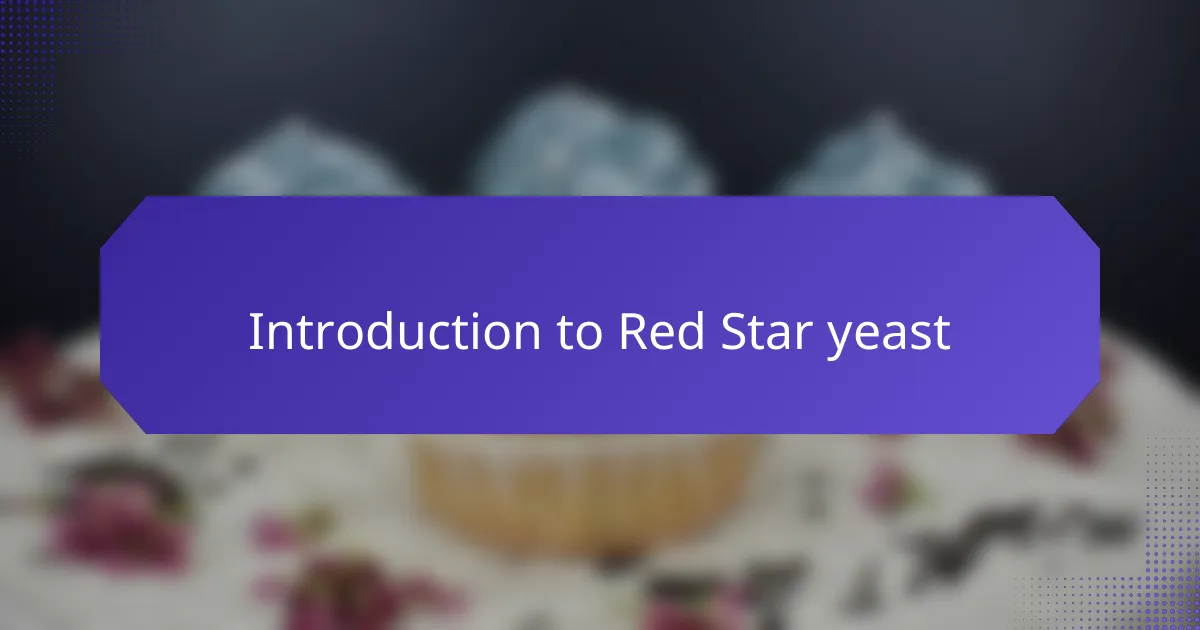
Introduction to Red Star yeast
Red Star yeast has been a trusted companion in my baking adventures for years. When I first started making bread, I was overwhelmed by the various options available, but Red Star’s reliability stood out to me. The yeast consistently yields fluffy, delicious loaves, which has made my baking experience not only easier but also more enjoyable.
What I love most about Red Star yeast is its versatility. Whether I’m whipping up a classic white bread or experimenting with artisan styles, I appreciate the consistent results. Here’s what I find noteworthy about Red Star yeast:
- Proven Quality: Trusted by bakers for over a century, it offers reliability and consistency.
- Variety of Options: Red Star provides different types of yeast, like Active Dry and Instant, catering to various baking styles.
- Easy to Use: Its straightforward instructions make it beginner-friendly, easing the intimidation often associated with bread-making.
- Wide Availability: You can easily find Red Star yeast in most grocery stores, making it accessible for everyone eager to bake.
In my experience, having a dependable yeast like Red Star has transformed my kitchen into a haven of creativity and comfort.
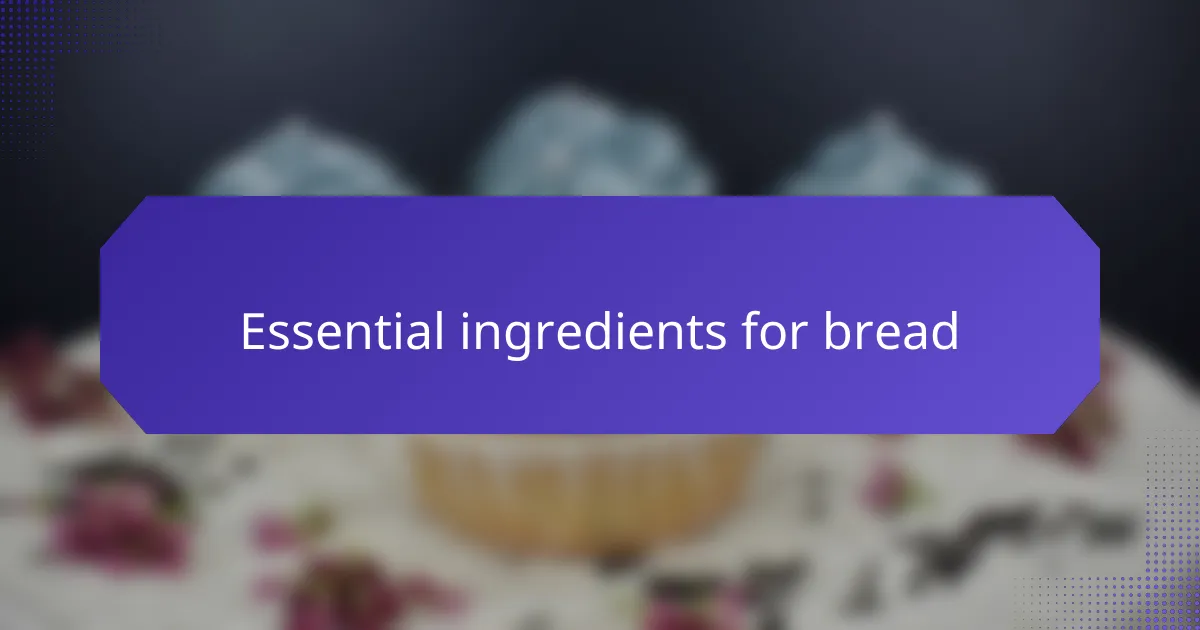
Essential ingredients for bread
When I first started baking bread with yeast, I quickly realized that the right ingredients could make all the difference. Using high-quality ingredients not only enhances the flavor but also affects the texture. I was surprised at how much I enjoyed experimenting with different flours and how they transformed my loaves.
Here are the essential ingredients you’ll need to get started on your bread-making journey:
- All-purpose flour: A versatile base for most bread recipes that provides the necessary gluten structure.
- Red Star yeast: This is my go-to yeast; it’s reliable and gives a nice rise to the dough.
- Warm water: Activates the yeast, so make sure it’s the perfect temperature—around 110°F (43°C).
- Sugar: A little sweetness helps feed the yeast, leading to a better rise and flavor.
- Salt: Enhances flavor and controls yeast activity—don’t skip it!
- Olive oil or melted butter: Adds richness and moistness to the bread, making it more indulgent.
By gathering these ingredients, you’re setting the foundation for a successful bread-baking experience, just like I did on my first attempt. Who knew a loaf of bread could bring so much joy?
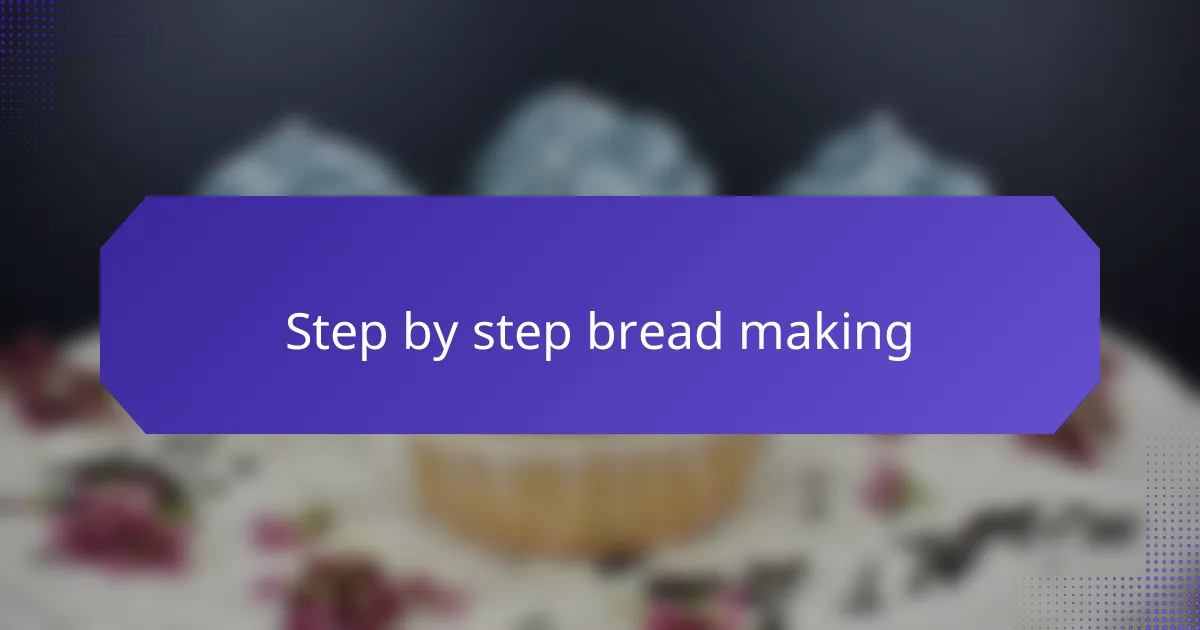
Step by step bread making
When it comes to making bread with yeast, the step-by-step process is not just about following a recipe—it’s about engaging with the ingredients and feeling that wonderful transformation happen. I still remember the first time I watched the dough rise. There’s something magical about seeing that yeast work its wonders. You can almost feel the anticipation in the air as the aroma of fresh bread fills your kitchen.
Start by combining warm water with yeast and a little sugar; I used Red Star Yeast, which is reliable and gives a lovely rise. After letting the mixture rest for about 5–10 minutes until it’s foamy, mix in your flour and salt. Kneading the dough, I find, is an essential moment—it’s where you can really connect with what you’re creating. Don’t rush this step; it’s therapeutic!
Next, let your dough rise in a warm place until it doubles in size—this can take about an hour. I always find that this waiting period is filled with excitement. Finally, shaping the dough and letting it rise again before baking is where you see all your hard work come together. You’ll be rewarded with a beautiful, golden loaf that’s perfect for any occasion.
| Step | Description |
|---|---|
| 1. Combine Ingredients | Mix warm water, sugar, and Red Star Yeast. Let sit until foamy. |
| 2. Mix & Knead | Add flour and salt, then knead until smooth and elastic. |
| 3. First Rise | Place dough in a warm area until doubled in size, about 1 hour. |
| 4. Shape & Second Rise | Shape the dough, let it rest again until it rises. |
| 5. Bake | Bake in a preheated oven until golden brown and cooked through. |
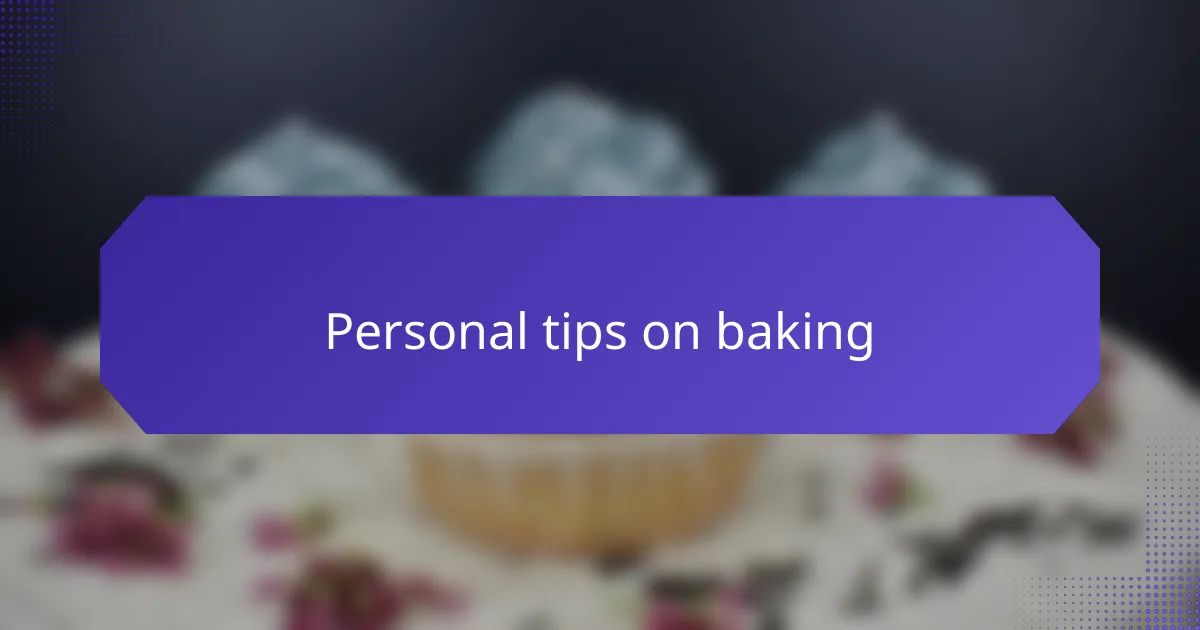
Personal tips on baking
When I first started baking with Red Star yeast, I learned that patience is key. The rise time can feel like an eternity, but that’s when the magic happens. I remember checking the dough every few minutes, filled with anticipation and a sprinkle of nerves, which made the experience all the more rewarding when it finally doubled in size.
One of the most helpful tips I’ve picked up over time is to use warm water, around 110°F, when dissolving the yeast. Too hot, and you risk killing it; too cold, and the yeast won’t activate properly. Trust me, hitting that sweet spot makes all the difference in achieving a beautiful loaf.
Here are some personal tips that transformed my baking experience:
- Always check the expiration date of your yeast; fresh yeast works best.
- Use a kitchen scale for precise measurements – it makes a huge difference!
- Don’t rush the dough; let it rise in a warm environment for optimal flavor and texture.
- If the dough feels too sticky, lightly flour your hands instead of adding too much flour.
- Trust your instincts; each kitchen is different, so adjust baking times and temperatures as needed.
